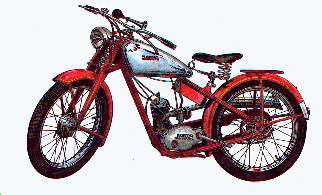 Go to the Archive index
Go to the Archive indexBuilt in Prague by the Janecek Arms Factory, the 1937 Jawa 'Robot' was a very advanced autocycle, especially when compared with its British contemporaries.
Firstly, let us consider the average pre-war British autocycle: little more than a much-stengthened and motorized bicycle, these machines were more often than not completely unsprung, and when a spring fork was fitted it was sometimes of a rather bizarre design. The typical engine was the Villiers Junior - sturdy and reliable, but a rather basic single-speed unit with its deflector piston and fixed head. Narrow trade-bike tyres added to the 'overgrown bicycle' appearance of these machines.
In comparison, the Czechoslovakian Jawa has more of the appearance of a lightened and simplified motor cycle - a motor cycle with pedals rather than a bicycle with an engine. The triangular pressed-steel frame derived its basic shape from a German motor cycle - the 'Wanderer' of 1927. Janecek started motor cycle production by building the Wanderer under licence and the name 'Jawa' was formed by combining 'Janecek' and 'Wanderer'.

The front of the Robot's frame was supported on a sprung girder fork. This suspension was controlled by a friction damper, adjustable by means of a large wing nut on the right hand side of the fork. The modern looking saddle tank was also derived from motor cycle practice. Braking was provided by conventional half-width drums front and rear.
Excepting its size at 98.8cc, the power unit would not have looked out of place on a moped of the 1960s. It was constructed in one unit with the pedalling gear and a three-speed gearbox. This meant that the Robot had only one drive-chain to the rear wheel rather than separate chains for the engine and pedals. The multi-plate clutch was manually operated, as was the gear box. The gear lever on the right hand side of the fuel tank has a somewhat vintage appearance in comparison with the rest of the machine; but foot change is impractical on an autocycle and it would be another 20 years before twist-grip change became popular. The engine itself was a flat-top piston two-stroke operating on the Schnurle system. Power output was 2.7hp at 3,750rpm. Ignition was provided by a flywheel magneto which also supplied current to the headlamp.
The legal status of the Czech and British machines also shows quite a contrast. Under Czech law, the fast, sophisticated Robot counted as a motorized bicycle - no tax, insurance, registration or driving licence were needed. Meanwhile in Britain the cruder and sluggish autocycles counted as motor cycles in the eyes of the law.
The Robot was a popular machine in Czechoslovakia. After World War II production was resumed by the now nationalized Jawa company and continued until 1947.
First published - April 1988